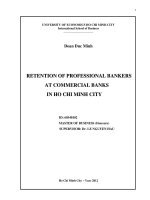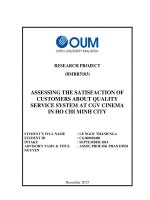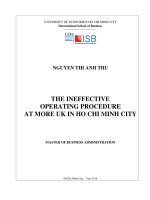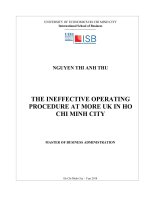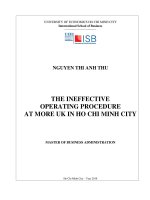Assessing the satisfaction of customers about quality service system at CGV cinema in ho chi minh city
Bạn đang xem bản rút gọn của tài liệu. Xem và tải ngay bản đầy đủ của tài liệu tại đây (1.7 MB, 121 trang )
RESEARCH PROJECT
(BMBR5103)
ASSESSING THE SATISFACTION OF
CUSTOMERS ABOUT QUALITY
SERVICE SYSTEM AT CGV CINEMA
IN HO CHI MINH CITY
STUDENT’S FULL NAME
STUDENT ID
INTAKE
ADVISOR’S NAME & TITLE
NGUYEN
: LE NGOC THANH NGA
: CGS00018488
: SEPTEMBER 2014
: ASSOC.PROF.DR. PHAN DINH
December 2015
Advisor’s assessment
..............................................................................................................................................................
..............................................................................................................................................................
..............................................................................................................................................................
..............................................................................................................................................................
..............................................................................................................................................................
..............................................................................................................................................................
..............................................................................................................................................................
..............................................................................................................................................................
..............................................................................................................................................................
..............................................................................................................................................................
..............................................................................................................................................................
..............................................................................................................................................................
..............................................................................................................................................................
..............................................................................................................................................................
..............................................................................................................................................................
..............................................................................................................................................................
..............................................................................................................................................................
..............................................................................................................................................................
..............................................................................................................................................................
..............................................................................................................................................................
..............................................................................................................................................................
Advisor’s signature
1
REASSURANCES
I swear thesis with topic “ASSESSING THE SATISFACTION OF CUSTOMERS
ABOUT QUALITY SERVICE SYSTEM AT CGV CINEMA IN HO CHI MINH
CITY”purely research findings of myself and has not been published in any work
of others. During the implementation process thesis, I have taken seriously the
research ethics rules; the results presented in the thesis is the research and personal
survey children, all references used in my thesis are the explicit instructions, in
accordance with regulations.
2
CONTENTS
CHAPTER 1:OVERVIEW OF THESIS .................................................................... 9
1.1
REASONS OF CHOOSING TOPIC .........................................................................9
1.2
OBJECTIVES ................................................................................................................... 10
1.3
RESEARCH SUBJECT ................................................................................................ 10
1.4
RESEARCH SCOPE ..................................................................................................... 10
1.5
THE METHODOLOGY .............................................................................................. 10
1.5.1
DATA ........................................................................................................................ 11
1.5.2
VARIABLE ............................................................................................................... 11
1.5.3
HYPOTHESIS ........................................................................................................ 12
1.5.4
MODEL ..................................................................................................................... 14
CHAPTER 2:LITERATURE REVIEW.................................................................. 16
2.1
THE CONCEPT OF SERVICE ................................................................................ 16
2.2
QUALITY OF SERVICE ............................................................................................ 16
2.2.1
The basic characteristics of service ................................................................. 17
2.2.1.1
Invisibility............................................................................................................... 18
2.2.1.2
Heterogeneity ....................................................................................................... 18
2.2.1.3
As of inseparable ................................................................................................ 18
2.2.1.4
As of not preserved............................................................................................. 19
2.2.2
Quality of Service Measurement ...................................................................... 19
2.2.3
Service quality model – SERVPERF MODEL ......................................... 21
2.2.4
Price .............................................................................................................................. 24
2.2.5
Customer satisfaction ............................................................................................ 24
2.2.6
The difference between service quality and customer satisfaction ... 25
2.3
RESEARCHING OF TOPICS MODEL ............................................................... 26
2.4
SUMMARY ....................................................................................................................... 27
CHAPTER 3:METHODOLOGICAL ...................................................................... 28
3
3.1
INTRODUCE .................................................................................................................... 28
3.2
COURSE OF RESEARCHING ................................................................................ 28
3.2.1
Description of the research process................................................................. 28
3.2.2
Diagram of the research ....................................................................................... 31
.......................................................................................................................................................... 32
3.3
RESEARCH PROPOSAL METHOD .................................................................. 33
3.3.1
RESEARCH MODEL ......................................................................................... 33
3.3.2
RESEARCH HYPOTHESIS ............................................................................. 34
3.3.2.1 Reliability and satisfaction customer ............................................................... 34
3.3.2.2
Response and customer satisfaction ........................................................... 34
3.3.2.3
Assurance and customer satisfaction ......................................................... 34
3.3.2.4
Empathy and customer satisfaction ............................................................ 35
3.3.2.5
Tangible and customer satisfaction ............................................................ 35
3.3.2.6
Price and customer satisfaction ................................................................... 35
3.4
MEASUREMENT SCALE CONTRUCTION................................................... 36
3.4.1
SERVICE QUALITY SCALE .......................................................................... 36
3.4.2
THE SCALE OF PRICE...................................................................................... 39
3.4.3
Customer satisfaction scale about service quality of CGV cinemas 40
3.4.4
Determining the accuracy and reliability of data ..................................... 40
3.5
SUMMARY ....................................................................................................................... 43
CHAPTER 4:SITUATION OF GORUP ENTERTAINMENT CJ CGVAND
ANALYZE RESEARCH RESULTS ........................................................................ 45
4.1
OVERVIEW OF THE COMPANY ........................................................................ 45
4.1.1
Company profile ...................................................................................................... 45
4.1.2
The process of constitute and development of CGV ............................... 45
4.1.3
The organization structure................................................................................... 47
.......................................................................................................................................................... 47
4
4.1.4
Functions and duties of the corporate structure ......................................... 48
4.1.5
Career and mission of the company ................................................................ 50
4.1.6
Development orientation of the company in the future .......................... 50
4.2
OVERVIEW OF THE BUSINESS OPERATIONS OF CGV CINEMA
IN HO CHI MINH BRANCH................................................................................................. 51
Results of business activities .................................................................................. 51
4.2.1
4.2.2
Some activities to enhance customer satisfaction by CGV Cinema . 53
4.3 SURVEY DATA ANALYSIS ........................................................................................ 56
4.3.1
Introduction................................................................................................................ 56
4.3.2
Characteristics information of the survey sample..................................... 56
4.3.3
Statistics descriptive the average value (MEAN) ..................................... 60
4.4
MEASUREMENT INSPECTION OF MODELS ............................................. 65
4.4.1
Cronbach's Alpha inspection for the scales ................................................. 66
4.4.2
Exploratory Factor Analysis (EFA) ................................................................ 67
4.4.3
General research model ........................................................................................ 70
4.4.4
Pearson Correlation coefficients analysis..................................................... 70
4.4.5
Regression analysis and testing the suitability of the model................ 72
4.4.6
Analysis of ANOVA variance ........................................................................... 77
4.5
CONCLUSION ................................................................................................................ 79
CHAPTER 5:SOLUTIONS AND RECOMEMDATIONS TO IMPROVE
QUALITY OF SERVICE IN GROUP ENTERTAINMENT MULTIMEDIA
CJ CGV VIETNAM ...................................................................................................... 80
5.1
SOLUTIONS
FOR
BUSINESS
OPERATIONS
OF
GROUP
ENTERTAIMENT MULTIMEDIA CJ CGV VIETNAM ........................................ 80
5.2
SOLUTIONS TO IMPROVE SERVICES SYSTEM AT CGV CINEMA
81
5.2.1
For tangible media elements (TAN) ............................................................... 81
5
5.2.2
For service pricing factors (PRI) ...................................................................... 82
5.2.3
For reliability factor (REL) ................................................................................. 84
5.2.4
For responsiveness factor (RES) ...................................................................... 85
5.2.5
For empathy factor (EMP) .................................................................................. 86
CONCLUSION ............................................................................................................... 88
CUSTOMERS SURVEYS SAMPLE ...................................................................................... 89
QUESTIONNAIRE SURVEYS .............................................................................................. 89
ADDENDUM 2 STATISTICAL DESCRIPTION AND "MEAN" AVERAGE
VALUE .................................................................................................................................................. 93
REFERENCES ................................................................................................................................ 120
6
LIST OF TABLES – FIGURES
Figure 2.1 - Model of service quality SERVPERF
Figure 2.2 - Model of customer satisfaction Zeithaml and CTG. (2009)
Figure 2.3 - research model is proposed in theory
Figure 3.1 - Research Process
Figure 3.2 - Research Proposal Method
Figure 4.1 – General research model
Table 3.1 - The scale of service quality components Megastar cinema CGV
Table 3.2 – Service pricing scale
Table 3.3 - Customer satisfaction scale about service quality
Table 4.1 - Report business operations of CGV Cinema - Ho Chi Minh City
Table 4.2 - Assess the level expectations of customers when they come cinema
CGV Cinemas
Table 4.3 – Mean values survey of "Reliability factor"
Table 4.4 – Mean values survey of "Response factor"
Table 4.5 – Mean values survey of "Assurance factor"
Table 4.6 – Mean values survey of "Empathy factor"
Table 4.7 – Mean values survey of "Tangible factor"
Table 4.8 – Mean values survey of "Price factor"
Table 4.9 – Mean values survey of "Satisfaction factor"
Table 4.10 – Cronbach 's Alpha of factors
7
Table 4.11 – The last results of EFA analysis
Table 4.12 – Summary of coefficients when factor analysis EFA
Table 4.13 – The table of corresponding factor analysis with the observed
variables
Table 4.14 –Pearson Correlationcoefficients analysis result
Table 4.15 – Summary results of the first regression analysis
Table 4.16 – Summary results of the second regression analysis
Table 4.17 – Summary of the necessary elements to test the suitability of the
model
Table 4:18 - Table testing variances customer groups surveyed by gender, age
group
and level of going to the cinema
Table 4:19 - Score Sig. comparing differences in satisfaction of the customer
groups surveyed by gender, age group and level going to the cinema
Chart 4.1 - The first cinema choice when going to the movies
Chart 4.2 - How often does customers go to the cinema
8
CHAPTER 1
OVERVIEW OF THESIS
1.1
PROBLEM STATEMENT
Nowadays, the economic has improved considerably. The level of living is
rising and that in parallel, their entertainment needs are pushed up. The new
entertainment forms appear constantly, but the traditional forms of entertainment
still have their foothold as the cinema, the first major market for businesses.
Therefore, the level of competition in this market is very high, including Vietnam
enterprises and foreign enterprises such as Galaxy (ThienNgan Company,
Vietnam), CGV and Megastar (CGV Communication Co., Ltd., Korea Korea),
Lotte Cinema (Lotte Cinema, South Korea), BHD (BinhHanh Dang Company,
Vietnam)….
These enterprises wants to hold market share in Vietnam entertainment will
have to invest a lot in infrastructure, branding, product quality and service quality.
And the majority of businesses in this field not too skewed on infrastructure
investment initially. Which service quality and customer satisfaction, and one of
the vital elements of any enterprise?
Based on the importance of service quality and level of customer satisfaction, as
well as hope to gain a strong foothold at home to the competitors at home and
abroad. So I have decided to choose the topic “ASSESSING THE
SATISFACTION OF CUSTOMERS ABOUT QUALITY SERVICE SYSTEM
AT CGV CINEMA IN HO CHI MINH CITY”. To find out the weak points in the
work of customer service as well as promote further strong points are available.
Analysis of the data has been to be able to make timely business strategy and the
best fit for the business.
9
1.2
OBJECTIVES
Define “ASSESSING THE SATISFACTION OF CUSTOMERS ABOUT
QUALITY SERVICE SYSTEM AT CGV CINEMA IN HO CHI MINH CITY”
through the following elements:
Service approach
Facilities
The level of customer responsiveness
Effective for results
The level of empathy
From that, it makes recommendations and proposals for the cinema of
Megastar Media Company Limited in the organization and reform of features and
services to meet customer requirements.
1.3
RESEARCH SUBJECT
The object of the research study is the customer had been using the services
of CGV Cinema.
1.4
RESEARCH SCOPE
- Ground for: The Cinema CGV Cinemas in HCMC
- Time: Surveys and research in 03 weeks.
- Ground for: The Cinema CGV Cinemas in HCMC
- Time: Surveys and studies of three weeks.
1.5
THE METHODOLOGY
The research was done over two stages: a preliminary study using
qualitative methods and formal research using quantitative methods.
10
Preliminary research was done by collecting and analyzing relevant
documents from many different sources. Thereby, adjust and complement the
scale of the service quality at the Megastar CGV Cinema.
Look at the official use survey creation tool of Google. The questionnaire
was based on the basis of the model study of the subject in order to collect
information for data analysis and test research hypotheses. Method interview: to
gather more input from customers before the official survey. Mathematical
Statistical Methods: Data processing obtained by SPSS software.
1.5.1
DATA
Research will be done by informal methods of quantitative research carried
out as soon as the scale has been built, this research conducted direct surveys and
an online survey to gather survey data.
According to Hair and Ctg (2006) : The minimum sample size of 50,
preferably at the rate of 100 and observed (observations) / measurement variables
(items) is 5: 1, i.e. one measurement variable minimum required 5 observed
variables, it is best 10: 1 or more. "
To achieve the above sample size, they have made an online survey (using
the tool Google Docs) 50 sample and emit 180 questionnaires. Questionnaire by
the study subjects answered themselves as the main tool to collect data. The
questionnaire includes 31 statements, including statements about the quality of 27
services, 3 spoke about the price of services, 4 statements about customer
satisfaction. Each question is measured based on the 5-point ofLikert scale.
1.5.2
VARIABLE
There are 6 variables of the model of customer satisfaction below:
Reliability
11
Responsiveness
Assurance
Empathy
Tangible means
Price service
The scale consists of 27 scales preliminaries of 6 factors affecting customer
satisfaction and 4 scales for measuring the general level of customer satisfaction.
So, the purpose of qualitative research in order to discover the factors that
affect the quality of service and customer satisfaction, to adjust the scale to suit the
characteristics of the service.
1.5.3
HYPOTHESIS
Reliability and customer satisfaction
A good service should have high reliability for customers, especially in the
first time precisely perform the service, not to make any mistakes, promise to do
something at a certain time, it will do… Thus, the confidence of customers to the
service of CGV Cinema also has an impact on customer satisfaction. So the first
research hypothesis is stated as follows:
H1: Comments of customers for the reliability of this service increase or
decrease the level of their satisfaction towards services which increase or decrease.
Responsiveness and customer satisfaction
The company's response to customer of CGV Cinema is expressed
readiness to serve the company's offer in a timely manner and at the right time for
our customers, including such criteria as always ready to help, when customers the
need is there, never too busy to meet the needs of customers. Obviously, the level
12
of satisfaction is an important factor affecting the quality of services and customer
satisfaction when using its services. The second hypothesis is stated as follows:
H2: Feeling of the customer’s level of satisfaction is increased or decreased
their level of satisfaction with services which increase or decrease.
Assurance and satisfaction
Served competence of companies providing services to clients Cinema
demonstrate professionalism and respect for clients including the criteria for
professionalism, courtesy, respect for customers and the ability to communicate .
Thus, the service capability is an important factor affecting the quality of service
and customer satisfaction when using the service to watch movies. The 3rd
hypothesis is stated as follows:
H3: Comment of customers about increasing or decreasing assurance lead
to the level of their satisfaction towards services which increase or decrease.
Empathy and customer satisfaction
Empathy of providing services companies to clients also has an impact on
customers, as they recognize the quality of higher screening service. Empathy
express customer care, listen and absorb customer reviews anytime, anywhere
business of providing services. This makes the company look more sympathetic in
the eyes of clients, have an impact on customer satisfaction. So, can speak 4th
hypothesis is as follows:
H4: When the level of customer empathy were assessed raise or lower, the
customer satisfaction will increase or decrease, respectively.
Tangible means and customer satisfaction
13
Tangible means is one of the important issues especially in screening
services. This is one of the factors that customers are interested in making
decisions using express services in more modern equipment than competitors,
preliminary attractive facilities, staff uniform ... As thus, perceived by customers
for tangible means of screening services also affects customer satisfaction. So 5th
hypotheses are stated as follows:
H5: Comments of customers on quality of service techniques the higher the
level of their satisfaction towards the higher service.
Prices and Customer Satisfaction
According to Zenithal and CTG. (2009) suggest that the price of the
services may affect the customer's perception of quality, satisfaction and service
value, because the services have a high invisibility and difficulty in implementing
judgments . Thus, the price of the services that affect to customer satisfaction. So
the 6th hypotheses stated as follows:
H6: Comment of customers on the appropriateness service charges higher
as the level of their satisfaction towards the higher service.
1.5.4
MODEL
Using regression to analyze factors is affect to the level of satisfaction on service
quality. Using regression correlation: Establish regression equation to find out the
extent of influence factors to the satisfaction of quality of system services CGV
cinemas in the city. From this analysis helps to detect the negative side, a positive
for reasonable solutions improve service quality at CGV cinema system.
The regression equation of the form:
Y = β0 + β1.X1 + β2.X2 + β3.X3 + β4.X4 + β5.X5 + β6.X6 + E
14
Where: Y: The degree of customer satisfaction on service quality of the system
CGV cinemas in the city.
β0: Coefficient freedom
β1, β2, β3, β4, β5, the slope
X1: Reliability
X2: Responsiveness
X3: Assurance
X4: Empathy
X5: Tangible means
X6: Price Services
15
CHAPTER 2
LITERATURE REVIEW
2.1 THE CONCEPT OF SERVICE
According to Vietnamese Dictionary, serviceis a work to direct service to
the specific needs of large number organized and paid.
According to Zeithaml&Britner (2000), the service is the act, process,
how to perform a particular job in order to create value for customers to use to
satisfy the needs and expectations of customers.
According to ISO 8402, "Service is the result generated by the operations
of contact between the supplier and the customer and the internal operations of the
suppliers to meet customers' needs."
From the above definition shows that the entertainment sector is also a
type of direct services to the specific needs of customers and the majority are paid.
In summary, there are many service concepts are stated under the same angle, but
in general, the hotel service activity is intended to meet the specific needs of
people.
2.2 QUALITY OF SERVICE
Quality of service is a problem is the managers are very interested in the
current business period. A product of good quality are not necessarily customers
choose to purchase if the service comes with the product is assessed as low.
Currently there are many different definitions of service quality, but it is
generally defined quality of service is what customers perceive. Each client has
cognitive and different needs should feel about the quality of service is different.
16
According to Juran (1988): "Quality is conformance to requirements"
(Fitness for Purpose).
According to Feigenbaum (1991): "Quality is the customer's decision is
based on practical experience with the product or service, measured based on
customer requirements, these requirements may be raised or not yet, be conscious
or simply feel, entirely subjective or professional nature and has always
represented the goal in a competitive market. "
According Lehtinen&Lehtinen (1982) suggests that service quality must
be assessed on two aspects which are the service provider and the service results.
According to Grönroos (1984) also suggested two areas of service quality,
which is the technical quality and functional quality. Technical quality concerning
what is offered and the quality of voice functions they served like.
However, when it comes to quality of service, we cannot fail to mention
the great contribution of Parasuraman and CTG. (1988, 1991). Parasuraman&
CTG. service quality definition is "different levels between the expectations of
consumers about the services and their awareness of the results of the service".
2.2.1
The basic characteristics of service
Service is a special product, do not exist in the form of specific products
(tangible) as goods directly but it serves certain needs of society.
Services have many other characteristics with other commodities such as
invisibility, heterogeneity, as inseparable and are not stored. These characteristics
make the service becomes difficult to quantify and cannot be identified with the
naked eye
17
2.2.1.1
Invisibility
Services can only be realized by the mind or senses one cannot "touch"
service products and services cannot be measured by the conventional method of
measuring the volume, weight.
A special form of existence of increasingly popular services such as
information, particularly in the service sector brought modernity as consulting,
legal, audiovisual services, telecommunications, computer ... the process of
manufacturing and marketing associated with the operation of this service may
take place not at the same time as commonly found in other common services such
as distribution, health care, transportation or tourism ... but which claim ask direct
contact between service providers and consumers.
2.2.1.2
Heterogeneity
Each customer has preferences, habits are not the same as the difference in
the geographical area, the influence of different cultures to the lifestyle, the
difference in psychological and physical, we experience the use many times....
they have the requirements, evaluation of the quality of different services. From
this we can see that it is difficult to give general criteria for the products and
services (services often personalized). This forces the service to offer appropriate
services to each audience in order to meet the highest demands from customers.
2.2.1.3
As of inseparable
Calculate the integral of express service in the difficult split into two
phase service is definitely the production phase and the use phase. Services are
typically created and used simultaneously. For commodity products, customers
use the product only in the final stage and for service, customer or partner during
part of the service creation process.
18
2.2.1.4
As of not preserved
Services cannot be kept, stored and sold like other commodities. Unable to
purchase tickets to football matches to watch another match. Emptiness captures
of service is not so big problem if the demand is steady demand and predictable.
But real demands for services often unstable, fluctuating, the company providing
services to meet the problem constraints of human use issues and technical
facilities.
2.2.2
Quality of Service Measurement
There are so many different scales used to measure and assess the quality
of services, they suit each specific service, and all have one thing in common that
is shown is the level of satisfaction that customers feel receive when they use the
service.
However, Parasuraman& CTG. (1985) who has conceptualized the
components of service quality perceived by customers to be able to design a ladder
measure it. The researchers said that, any service, quality of service perceived by
customers can describe the 10 components, namely:
‒ Trust (reliability) say the ability to perform appropriate service and on time
at first.
‒ Response (responsiveness) to speak the desire and willingness of staff
providing services to customers.
‒ Capacity serving (competence in) speaks qualified to perform the services.
Professional competence is necessary for employees in contact with
customers, employees directly performing the service, the ability to make
research to capture the relevant information needed to serve customers.
19
‒ Reach (access) involves creating conditions for customer ease of access to
services such as shortening the waiting time of customers, service locations
and opening hours convenient to the client.
‒ Courtesy (courtesy) voice service affable personality, respect, and
customer friendly.
‒ Communication
(communication)
involves
communicating;
communicating to customers in a language they easily understand and
listen to them on matters related to the interpretation services they like,
cost, and handling complaints Inquiries complaints.
‒ Trust (credibility) says the ability to create customer confidence, makes
customers rely on the company. This ability is reflected in the name and
reputation of the company, the personality of the service personnel to
communicate directly with customers.
‒ Safety (security) related to the ability to ensure the safety of customers,
expressed through physical safety, finance, and information security.
‒ Understanding the customer reflected the ability of understanding the
needs of customers through the understanding of customer requirements,
individual attention to them and recognizes regular customers.
‒ Tangible Media (tangibles) reflected looks, attire service personnel,
equipment and service for the service.
‒ Model 10 components of quality of such services have the advantage of
covering almost every aspect of a service. However, the model has the
disadvantage of complexity in the measurement. Therefore, researchers
have repeatedly tested this model and come to the conclusion that service
quality consists of 5 basic components, namely:
‒ Trust (reliability) says the ability to perform appropriate service and on
time at first.
20
‒ Response (responsiveness): speak the desire and willingness of staff
providing services to customers.
‒ Guaranteed (assurance): The qualities of employees will create confidence
for clients: professionalism, courtesy, respect for customers, the ability to
communicate.
‒ Empathy (Empathy): showing care to each individual customer.
‒ Tangible Media (tangibles): expressed through looks, attire service
personnel, equipment and service for the service.
‒ Model 5 component of quality basic services have also been used by
researchers to measure the quality of services in many different areas as
well as in many different markets. The test results show that service quality
is not consistent with each other in various service sectors. Another issue
that arises is the importance of each component of quality of service for
customer satisfaction. Therefore, further research is needed in this area.
2.2.3
Service quality model – SERVPERF MODEL
Based on SERVQUAL model of Parasuraman, Cronin and Taylor (1992)
were modified and modeling SERVPERF, a variant of SERVQUAL. According
SERVPERF model is: Quality Service = Level feel (instead of measuring the
perceived quality and expected as SERVQUAL). The author argues that the
quality of service is reflected best by the perceived quality without quality
expectations, as well as evaluating the weight of the 5 components. This
conclusion has received sympathy by studies by Lee et al (2000), Brady et al
(2002). From SERVQUAL, components and variations of scale SERVPERF
observe this as SERVQUAL hold. Measurement model is called model felt
(Perception model).
21
Both the non-assertion model and models all have felt further research
use. It is noteworthy that the study results showed that hard to conclude which
model is improper or even more properly.
22
Reliability
Responsiveness
Service capability
CUSTOMER
SATISFATION
Empathy
Tangible Means
Figure 2.1 - Model of service quality SERVPERF
SERVPERF Ministry scales also told 05 22 basic components similar to
asking about the customer's perception of the model SERVQUAL, however,
ignore the question of expectation, five basic components, namely:
- Trust (reliability): expressed by the ability to perform appropriate service
and on time right from the first time.
- Response (responsiveness) reflected the desire, willingness of service
personnel provide timely service to customers.
- Capacity serving (assurance) expressed qualifications and offering a
polite, affable with customers.
- Empathy (empathy) expressed concern and care to each individual
customer.
23
- Tangible means (tangibles): expressed through looks, attire of the staff,
equipment and service for the service.
In summary, two models of quality measurement services have pros and
cons. Two models SERVQUAL and SERVPERF often used to assess service
quality assess customer satisfaction in the economic field.
2.2.4
Price
According to Cronin & Taylor (1992), the customer service is not
necessarily buy the best quality they can buy services that give them more
satisfaction. Therefore, factors such as customer awareness about prices may
affect their levels of satisfaction, although they do not affect the service quality.
On the other hand, Zeithaml and CTG. (2009) suggest that the price of the
services may affect the customer's perception of quality, satisfaction and service
value, because the services have a high invisibility and difficulty in implementing
judgments.
2.2.5
Customer satisfaction
There are many definitions of customer satisfaction as:
According to Bachelet (1995) definition of customer satisfaction is an
emotional reactions of customers responded with their experience with a product
or service.
According to Oliver (1997) defined satisfaction is the reaction of
consumers to the desires is met. This definition implies that satisfaction is the
satisfaction of consumers in the consumption of products or services that it meets
their expectations, including on the level of response desired and below desired
levels.
24

